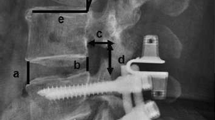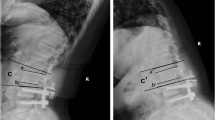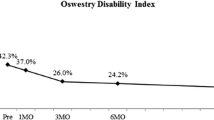Abstract
Study design
Prospective, randomized trial.
Purpose
The treatment of degenerative disc disease (DDD) with two-level fusion has been associated with a reasonable rate of complications. The aim of the present study was to compare (Hybrid) stand-alone anterior lumbar interbody fusion (ALIF) at L5/S1 with total disc replacement at L4/5 (TDR) as an alternative surgical strategy to (Fusion) 2-level circumferential fusion employing transforaminal lumbar interbody fusion (TLIF) with transpedicular stabilization at L4–S1.
Methods
A total of 62 patients with symptomatic DDD of segments L5/S1 (Modic ≥2°) and L4/5 (Modic ≤2°; positive discography) were enrolled; 31 were treated with Hybrid and 31 with Fusion. Preoperatively, at 0, 12, and a mean follow-up of 37 months, clinical (ODI, VAS) and radiological evaluations (plain/extension-flexion radiographs evaluated for implant failure, fusion, global and segmental lordosis, and ROM) were performed.
Results
In 26 of 31 Hybrid and 24 of 31 Fusion patients available at the final follow-up, we found a significant clinical improvement compared to preoperatively. Hybrid patients had significantly lower VAS scores immediately postoperatively and at follow-up compared to Fusion patients. The complication rates were low and similar between the groups. Lumbar lordosis increased in both groups. The increase was mainly located at L4–S1 in the Hybrid group and at L1–L4 in the Fusion group. Hybrid patients presented with increased ROM at L4/5 and L3/4, and Fusion patients presented with increased ROM at L3/4, with significantly greater ROM at L3/4 compared to Hybrid patients at follow-up.
Conclusions
Hybrid surgery is a viable surgical alternative for the presented indication. Approach-related inferior trauma and the balanced restoration of lumbar lordosis resulted in superior clinical outcomes compared to two-level circumferential fusion with TLIF.









Similar content being viewed by others
References
Fritzell P, Hagg O, Wessberg P, Nordwall A (2001) 2001 Volvo award winner in clinical studies: lumbar fusion versus nonsurgical treatment for chronic low back pain: a multicenter randomized controlled trial from the Swedish Lumbar Spine Study Group. Spine (Phila Pa 1976) 26:2521–2532
Kumar MN, Baklanov A, Chopin D (2001) Correlation between sagittal plane changes and adjacent segment degeneration following lumbar spine fusion. Eur Spine J 10:314–319
Kumar MN, Jacquot F, Hall H (2001) Long-term follow-up of functional outcomes and radiographic changes at adjacent levels following lumbar spine fusion for degenerative disc disease. Eur Spine J 10:309–313
Park P, Garton HJ, Gala VC, Hoff JT, McGillicuddy JE (2004) Adjacent segment disease after lumbar or lumbosacral fusion: review of the literature. Spine (Phila Pa 1976) 29:1938–1944
Chrastil J, Patel AA (2012) Complications associated with posterior and transforaminal lumbar interbody fusion. J Am Acad Orthop Surg 20:283–291
Jones-Quaidoo SM, Djurasovic M, Owens RK 2nd, Carreon LY (2013) Superior articulating facet violation: percutaneous versus open techniques. J Neurosurg Spine 18:593–597
Dede O, Thuillier D, Pekmezci M, Ames CP, Hu SS, Berven SH, Deviren V (2013) Revision surgery for lumbar pseudarthrosis. Spine J [Epub, ahead of print]
David T (2007) Long-term results of one-level lumbar arthroplasty: minimum 10-year follow-up of the CHARITE artificial disc in 106 patients. Spine (Phila Pa 1976) 32:661–666
Delamarter R, Zigler JE, Balderston RA, Cammisa FP, Goldstein JA, Spivak JM (2011) Prospective, randomized, multicenter Food and Drug Administration investigational device exemption study of the ProDisc-L total disc replacement compared with circumferential arthrodesis for the treatment of two-level lumbar degenerative disc disease: results at twenty-four months. J Bone Joint Surg Am 93:705–715
Panjabi M, Henderson G, Abjornson C, Yue J (2007) Multidirectional testing of one- and two-level ProDisc-L versus simulated fusions. Spine (Phila Pa 1976) 32:1311–1319
Harrop JS, Youssef JA, Maltenfort M, Vorwald P, Jabbour P, Bono CM, Goldfarb N, Vaccaro AR, Hilibrand AS (2008) Lumbar adjacent segment degeneration and disease after arthrodesis and total disc arthroplasty. Spine (Phila Pa 1976) 33:1701–1707
Le Huec JC (2011) Artificial disks: modest medium- and long-term benefits and a need for better patient selection. Joint Bone Spine 78:441–444
Pellet N, Aunoble S, Meyrat R, Rigal J, Le Huec JC (2011) Sagittal balance parameters influence indications for lumbar disc arthroplasty or ALIF. Eur Spine J 20(Suppl 5):647–662
Tournier C, Aunoble S, Le Huec JC, Lemaire JP, Tropiano P, Lafage V, Skalli W (2007) Total disc arthroplasty: consequences for sagittal balance and lumbar spine movement. Eur Spine J 16:411–421
Saberi H, Rahimi L, Jahani L (2009) A comparative MRI study of upper and lower lumbar motion segments in patients with low back pain. J Spinal Disord Tech 22:507–510
Tropiano P, Huang RC, Girardi FP, Cammisa FP Jr, Marnay T (2005) Lumbar total disc replacement. Seven to eleven-year follow-up. J Bone Joint Surg Am 87:490–496
Siepe CJ, Mayer HM, Heinz-Leisenheimer M, Korge A (2007) Total lumbar disc replacement: different results for different levels. Spine (Phila Pa 1976) 32:782–790
Strube P, Hoff EK, Perka CF, Gross C, Putzier M (2012) Influence of the type of the sagittal profile on clinical results of lumbar total disc replacement after a mean follow-up of 39 months. J Spinal Disord Tech [E-pub, ahead of print]
Strube P, Hoff EK, Schmidt H, Dreischarf M, Rohlmann A, Putzier M (2013) Parameters influencing the outcome after total disc replacement at the lumbosacral junction. Part 2: distraction and posterior translation lead to clinical failure after a mean follow-up of 5 years. Eur Spine J 22:2279–2287
Siepe CJ, Zelenkov P, Sauri-Barraza JC, Szeimies U, Grubinger T, Tepass A, Stabler A, Mayer MH (2010) The fate of facet joint and adjacent level disc degeneration following total lumbar disc replacement: a prospective clinical, X-ray, and magnetic resonance imaging investigation. Spine (Phila Pa 1976) 35:1991–2003
Hoff E, Strube P, Gross C, Hartwig T, Putzier M (2010) Monosegmental anterior lumbar interbody fusion with the SynFix-LR device. A prospective 2-year follow-up study. Orthopade 39:1044–1050
Aunoble S, Meyrat R, Al Sawad Y, Tournier C, Leijssen P, Le Huec JC (2010) Hybrid construct for two levels disc disease in lumbar spine. Eur Spine J 19:290–296
Strube P, Tohtz S, Hoff E, Gross C, Perka C, Putzier M (2010) Dynamic stabilization adjacent to single-level fusion: part I. biomechanical effects on lumbar spinal motion. Eur Spine J 19:2171–2180
Glassman SD, Carreon LY, Djurasovic M, Dimar JR, Johnson JR, Puno RM, Campbell MJ (2009) Lumbar fusion outcomes stratified by specific diagnostic indication. Spine J 9:13–21
Goldstein CL, Macwan K, Sundararajan K, Rampersaud YR (2014) Comparative outcomes of minimally invasive surgery for posterior lumbar fusion: a systematic review. Clin Orthop Relat Res 472:1727–1737
Geisler FH, Blumenthal SL, Guyer RD, McAfee PC, Regan JJ, Johnson JP, Mullin B (2004) Neurological complications of lumbar artificial disc replacement and comparison of clinical results with those related to lumbar arthrodesis in the literature: results of a multicenter, prospective, randomized investigational device exemption study of Charite intervertebral disc. Invited submission from the joint section meeting on disorders of the spine and peripheral nerves, March 2004. J Neurosurg Spine 1:143–154
Fan S, Hu Z, Zhao F, Zhao X, Huang Y, Fang X (2010) Multifidus muscle changes and clinical effects of one-level posterior lumbar interbody fusion: minimally invasive procedure versus conventional open approach. Eur Spine J 19:316–324
Motosuneya T, Asazuma T, Tsuji T, Watanabe H, Nakayama Y, Nemoto K (2006) Postoperative change of the cross-sectional area of back musculature after 5 surgical procedures as assessed by magnetic resonance imaging. J Spinal Disord Tech 19:318–322
He B, Yan L, Guo H, Liu T, Wang X, Hao D (2014) The difference in superior adjacent segment pathology after lumbar posterolateral fusion by using 2 different pedicle screw insertion techniques in 9-year minimum follow-up. Spine (Phila Pa 1976) 39:1093–1098
Barrey C, Jund J, Noseda O, Roussouly P (2007) Sagittal balance of the pelvis-spine complex and lumbar degenerative diseases. A comparative study about 85 cases. Eur Spine J 16:1459–1467
Jiang SD, Chen JW, Jiang LS (2012) Which procedure is better for lumbar interbody fusion: anterior lumbar interbody fusion or transforaminal lumbar interbody fusion? Arch Orthop Trauma Surg 132:1259–1266
Schwab F, Lafage V, Patel A, Farcy JP (2009) Sagittal plane considerations and the pelvis in the adult patient. Spine (Phila Pa 1976) 34:1828–1833
Umehara S, Zindrick MR, Patwardhan AG, Havey RM, Vrbos LA, Knight GW, Miyano S, Kirincic M, Kaneda K, Lorenz MA (2000) The biomechanical effect of postoperative hypolordosis in instrumented lumbar fusion on instrumented and adjacent spinal segments. Spine (Phila Pa 1976) 25:1617–1624
Hoh DJ, Wang MY, Ritland SL (2010) Anatomic features of the paramedian muscle-splitting approaches to the lumbar spine. Neurosurgery 66:13–24
Yoshihara H, Yoneoka D (2015) National trends in the surgical treatment for lumbar degenerative disc disease: United States, 2000 to 2009. Spine J 15:265–271
Acknowledgments
The analysis of the radiologic parameters was financially supported in part by the German Research Foundation (DFG) under Project No. PU 510/2-1. The funders had no role in study design, data collection and analysis, decision to publish, or preparation of the manuscript.
Conflict of interest
None.
Author information
Authors and Affiliations
Corresponding author
Rights and permissions
About this article
Cite this article
Hoff, E.K., Strube, P., Pumberger, M. et al. ALIF and total disc replacement versus 2-level circumferential fusion with TLIF: a prospective, randomized, clinical and radiological trial. Eur Spine J 25, 1558–1566 (2016). https://doi.org/10.1007/s00586-015-3852-y
Received:
Revised:
Accepted:
Published:
Issue Date:
DOI: https://doi.org/10.1007/s00586-015-3852-y




